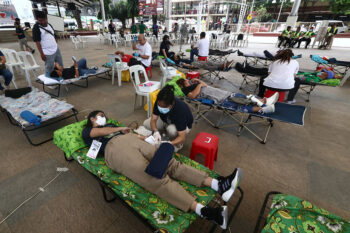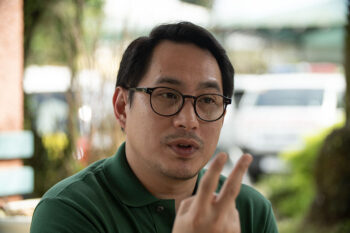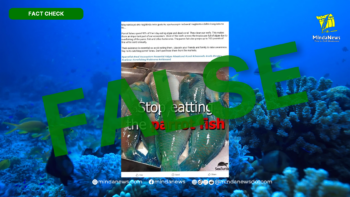“Ang galaw ng wika ay papalawak, hindi papakitid” – WIKApedia (2017)
ZAMBOANGA CITY (MindaNews / 28 January) — A particular WIKApedia post on Facebook caught my attention; in particular as it explains “kaganina” and “kagahapon”, which are obviously Filipino-Cebuano or Filipino-Binisiya combination. If you are curious about it, follow this link – https://www.facebook.com/wikapediaph/photos/pb.846657968700849.-2207520000.1485404629./1423908380975802/?type=3&theater.
The explanation runs this way, “Sa wika, may tinatawag tayong dayalek, sosyolek, at idyolek, kaya maging mapanuri sa tuwing sinasabi nating ‘mali’ ang isang salita, ay mali na ito talaga. Baka hindi lang ginagamit sa lugar ninyo. Pero hindi ibig sabihin, kapag hindi ginagamit sa lugar ninyo, lalo na sa Maynila, ay mali na.”
Thus, nothing is wrong with variation. Also, we should not be hasty in judging people. The last line got into me: “ang galaw ng wika ay papalawak, hindi papakitid”; roughly, “the language movement is expansion, not constriction”. This statement cut right through the perennial debate between “purists” and “pragmatists” and the dominance of language variation in the Metro as arbiter of what is right as opposed to variations across regions and localities.
I am no language expert or linguist. I am a lay person interested in language because it forms part of culture, which means understanding the nuances of language helps us understand our culture properly and deeply. So I researched online to know more about nuances of language variation. Here’s what I found:
Variation 1: Accent
Variation in pronunciation is accent, that rising or wavy intonation. For example language speakers can expose their geographic origin by their intonation. A Maguindanaon speaker can be identified as “Sa Raya” (from hinterland) or “Sa Ilod” (coastal) by just listening to their intonation; in the same manner a resident of Metro Manila from a Mindanawon in the way they speak Filipino, the national language. Similarly, variation in accent is also found among Tausug in the coastal and hinterland areas; as well as the coastal Illanun and hinterland Iranun.
Francois de La Rochefoucauld, the 17th century noted French author of maxims and memoirs has this to say about, “the accent of one’s birthplace remains in the mind and in the heart as in one’s speech”.
Variation 2: Dialect
Language may have another form of variation called dialect. The online Cambridge dictionary defines it as, “a form of a language that is spoken in a particular part of a country or by a particular group of people and that contains some words, grammar, or pronunciations (= the ways in which words are said) that are different from the forms used in other parts or by other groups.” In short, dialect is mark by particular grammar, lexicon (words) and pronunciation.
This explains the variation of Sinama spoken in Tongkil (among the Bangingi), Pangutaran, Tawi-Tawi and Siasi (among the Bajaw). These are just few dialects of the Sinama spoken throughout the Sama-Bajaw world. We therefore expect more Sinama dialects as we move out of the Philippines and towards the Sama-Bajaw communities in Malaysia and Indonesia.
Can we consider also the Inabaknon of the Abaknon people largely in Capul Island off the coast of Western Samar as a Sinama dialect because it is part of the Sama-Bajaw language configuration? Are Iyakan and Jama Mapun considered language on their own or can they be considered Sinama dialects within the Sama-Bajaw language configuration?
Within Tawi-Tawi, there are also observable variations especially in use of words (lexicon) and pronunciation among Sinama speakers in Sibutu-Sitangkai, Simunul and the Eastern Kapoan region encompassing Ubian, Tandubas, Sapa-Sapa, Bellatan and Balimbing. Are these Sinama Simunul, Sinama Sibutu and Sinama Kapoan dialects or sub-dialects under Sinama Tawi-Tawi?
The late Sama historian from Ubian Muhammad Kurais II put forward in one of his books that the Bajaw is a “danakan” (sibling) of the Sama people. In this same manner, I would like to put forward the merit of discussion about dialects and sub-dialects.
On a more contemporary note, Susanna Kearsely, New York Times best-selling Canadian novelist of historical fiction and mystery, as well as thrillers under the pen name Emma Cole, expresses the challenge of dialects when writing. She said, “Such is the endless dilemma of dialect. Not every reader will ever agree with the way that I handle it, no matter how hard I work to keep everything readable. But again it’s that balance I have to maintain between keeping it easy and keeping it real, and I know that I’ll never please everyone.”
Variation 3: Sociolect
Sociolect is that variety in language associated and due to education, social class or religion. We can then say that the Sinug spoken by ulama with their own lexicon of Arabic loanwords and adoption of Arabic language rules is a sociolect of the Bahasa Sug. Their preferred orthography reflects a transliteration of the Arabic alphabet. Their preference for kunya, an Arabic practice of honoring the parents based on the name of their first child. Thus, if my first born is a baby girl named Salma, my kunya as the father is “Abu Salma” (Father of Salma) and my wife’s kunya will be “Umm Salma” (Mother of Salma). The entire tapestry of Tausug religious beliefs and practices is full of Arabic loanwords – dunya (mundane), akhirah (hereafter), salah (prayer), dua (supplication), tawhid (monotheism), iman (faith), wudhu’ (ablution), adhan (call to prayer), etc.
In the same manner, the spoken Sinug of professionals with its lexicon of imported English and Filipino words and grammar rules is a sociolect of the Bahasa. Professional Tausugs speak their language with ease by mingling in with English and Filipino words or words associated with their respective profession. It is because of our exposure to Spanish, English and Filipino that we begin adopting their vowels and diphthongs, despite the fact that, for example, the Sinug language has also three short vowels (a, i, u).
I wonder if we still have that ‘royal’ Sinug variant spoken at court and used in official royal correspondence. This sociolect is full of third person addresses and deferent words, a class of words that respond but confront in profound manner. This court Sinug is considered as “pure” Sinug or classical Sinug. Together with the Sinug spoken by the ulama, they are considered as acrolects, a sociolect of high status or prestige. This is in contrast with bacilect, a Sinug spoken by non-Tausug, including the vulgar and the slang. I assume that the Meranaw, Iranun and the Maguindanaon have their own court sociolect because of their history of Pat-a-pangampong, Sultanate of Maguindanao and the Rajanate of Buayan.
A language is a type of social behavior, said Ferdinand de Saussure, who is considered father of modern linguistics; sociolect is therefore an important driver of both language development and propagation.
Variation 3: Idiolect
Idiolect is the language of a single person. The way each one of us expresses our Sinug is an idiolect. Idiolect can be “imposed” or adopted by the community especially if it is coming from a person of influence or authority.
We are reminded by KWF that in view of the diversity in accent, dialects, sociolects and idiolects, we should be careful in arguing around the question of right or wrong because language is supposed to accommodate, to expand, to grow and not to constrict or to stagnate.
Language grows and survives by expanding to accommodate varied types of speakers; thus it is organic, not static.
There’s a free verse poem from Katherine Thwaite. The last few lines capture the essence of language:
Idiolect, sociolect, circumspect?
Words reveal the lost soul.
But not the whole story.
Play it again
But this time
Speak it.
I want to hear the music
Of you.
(MindaViews is the opinion section of MindaNews. Noor Saada is a Tausug of mixed ancestry – born in Jolo, Sulu, grew up in Tawi-tawi, studied in Zamboanga and worked in Davao, Makati and Cotabato. He is a development worker and peace advocate, former Assistant Regional Secretary of the Department of Education in the Autonomous Region in Muslim Mindanao, currently working as an independent consultant and is a member of an insider-mediation group that aims to promote intra-Moro dialogue).







